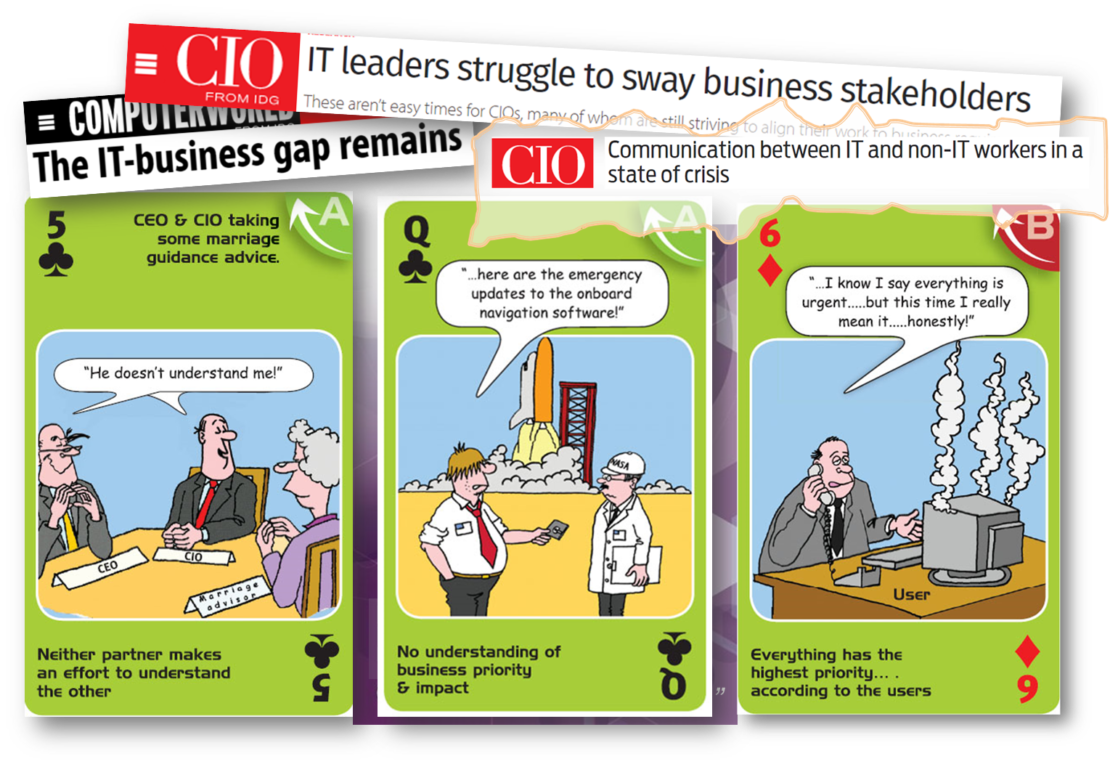Publikováno: 7. 12. 2020
Written by: Paul Wilkinson
Are YOU gambling with YOUR IT?
In part 1 of this 2 part article we explored the Elephant in the room – Value – and walked through a scenario from our MarsLander simulation to reveal recognized challenges facing many organizations. Yet these challenges are not new? They are long standing challenges, that, If we do not address them will put our transformation ambitions at risk.
What are these challenges? And If they are such long standing challenges, why have we failed to address them so far?
In the seminar ‘ITSM Practice’ organized by itSMF Czech Republic, we compared the experiences in the simulation exercise described in Part 1 with top ABC (Attitude, Behavior, Culture) challenges captured in global workshops for the last 15 years – In a row. Challenges relating to Business and IT and the realization of VALUE.
‘This may be a winning hand in Black Jack (21) – but if you recognize these cards below and are NOT addressing them then you have to ask yourself ‘Are we gambling with our IT?’’

We surveyed delegates to ask ‘Which challenge do you recognize in your organization?’

Observations: It was clear that different business unit managers all insisting that their work has the highest priority (driving their product owners to claim resources) is the most widely recognized challenge. If Product owners and Product teams are sharing resources, then this creates a conflict. In the situation described in part 1 above we had the Sales director insisting their work was the highest priority (Value and Outcomes) and the Flight Operations director insisting the problem be resolved (Costs and Risks) – both defending THEIR OWN Key business goals.
The result of the mini survey above is also very worrying when we consider the following findings from an ‘MIT Sloan Review Management survey’
“…The CEO was shocked at the results. Only one-quarter of the managers surveyed could list three of the company’s five strategic priorities. Even worse, one-third of the leaders charged with implementing the company’s strategy could not list even one”.
If Business managers do not know the strategic priorities, yet are insisting that THEIR work has the highest priority then we need a governance mechanism to help us prioritize based on Strategic Value and our Transformation ambitions?
But if we look at the results of ‘governance’ above? More than 30% suggested a lack of effective governance.
If we recognize these challenges above and are not working to resolve them then we are gambling with our ability for IT to support and enable the Value we need from Digital transformation.
Are you a gambler?
Do NOT Panic!
If we do not want to be a gambler then what can we do about it?
“Do not panic. I have a framework to relieve your pain. Please take one of more of these frameworks with a glass of water before you go to sleep and when you wake up everything will be OK again. If you cannot get to sleep just try counting Elephants.”
The majority of IT organizations adopt frameworks and new ways of working to resolve these challenges. We surveyed delegates and asked ‘Which of these frameworks have you adopted’?

Observations: If the challenges above are true – ‘Lack of business and IT awareness of strategic goals’, and ‘Various business units insisting their work has the highest priority’ then BRM and COBIT / ISO37000 are critical capabilities in order to gain ‘a shared understanding of business value’ and ‘apply effective governance to prioritize scarce resources’.
Yet less than 20% said they were adopting these frameworks (It may well be that they have other practices that demonstrate these capabilities).
The Value of Training
Adopting the right blend of frameworks is one thing. But we have been sending people on training in these frameworks for a long time and still have these challenges. Are we getting the right Value from our training investment? If not. Why not? ‘Are we learning the right things? And are we effectively transferring the learning into sustainable behaviors to ensure that we can, and are delivering value?’
We looked at the 8-field model, an approach to scoping training; for ensuring the transfer of learning; and for the measurement of impact from training. We surveyed delegates ‘Which levels do you measure to show the value of a training investment?’

Observations: 50% do not measure the transfer of learning into new behaviors and only 20% measure the business impact on Value resulting from training investment.
We often see that individuals on a training course are unclear of the Value of adopting a framework and are not facilitated in embedding the learning into new behaviors. This coupled with the lack of investing in BRM and Governance training puts our transformation ambition at risk, as well as our ability to understand and deliver Value.
That is one small step for man…..(hopefully not into Elephant doo-doo?) and one giant leap to who knows where.
Digital disruption has brought with it the need to transform. However it is not a one-time transformation. Change is relentless. We need to be able to continually align to changing needs and demands.
We have also seen that the transformation of ITSM from where we are now as a Service Provider to a Strategic Partner cannot be done in one giant leap. Continual improvement needs to be a core capability. The need to take iterative steps to improve, aligned to our business goals and transformation ambitions. However, without fully understanding what Value looks like could mean that our first steps take us in the wrong direction, and we end up stepping in the output produced by the Elephant in part 1 of this article. (Perhaps this is where the English expression came from ‘don’t put your foot in it’! ‘It’ being the sticky brown stuff more often referred to as hitting the fan).
Also, in order to solve the challenges above, which relate to both business & IT behavior change, will require that the improvement needs reach board level – certainly if want to solve the challenge of ‘Everything having the highest priority according to the business’. One challenge we have already seen, lack of BRM and IT governance frameworks limits our ability to align with and influence board decision making. Perhaps we can use Continual Improvement?
We surveyed delegates about the Value of Continual improvement by asking ‘Which of these represents YOUR organizations Continual Improvement capability?’

Observations: Almost 50% limit Continual Improvement to internal IT improvements. Almost half say it is aligned with business managers – if these are the same business managers as mentioned above in the MIT Sloan review findings then these will meet individual business silo needs only. Only about 15% say Continual Improvement feeds into Governance.
As stated in ITIL4 “The Governing body should also have visibility of the outcomes of continual improvement activities and the measurement of value for the organization…”
Conclusions:
Value is a complex topic. It varies from stakeholder to stakeholder, it changes over time, in this age of agile transformation decisions relating to Value needs to flow quickly from top to bottom (strategic to operational) Value needs to pass consistently from left to right through Value streams (breaking down SILOs). Which means we must collaborate effectively end-to-end.
The increasing amount of demands for IT and the scarcity of resources means that some stakeholders will NOT get the Value they had expected – this needs to be a conscious decision that does not put organizational Value at risk. This requires ‘co-creation’ of value enable through effective decision making capabilities.
Transforming from where we are now to where we need to be represents a significant step. This is NOT a one-time implementation. It is a leap that will require Continual improvement as a strategic capability. Yet for many Continual Improvement is too SILOed and not aligned with transformation ambitions.
If we look at the results of the mini surveys (small population) we can see significant challenges that need to be addressed. These can only be addressed by engaging with stakeholders to co-create Value and by developing the right skills and behaviors to support the transformation. Currently we do not optimize the Value from our training investments to transfer the learning into demonstrable behaviors and measured Value.
Failing to address these challenges means that you will be gambling with your IT and your organizations Transformation ambitions.
As mentioned above these were the findings from a survey of a small population. Please take time to complete the survey so that we can use the results in the itSMF Czech Republic annual conference 20-21 January 2021.
Autor:: Jaroslav Rokyta